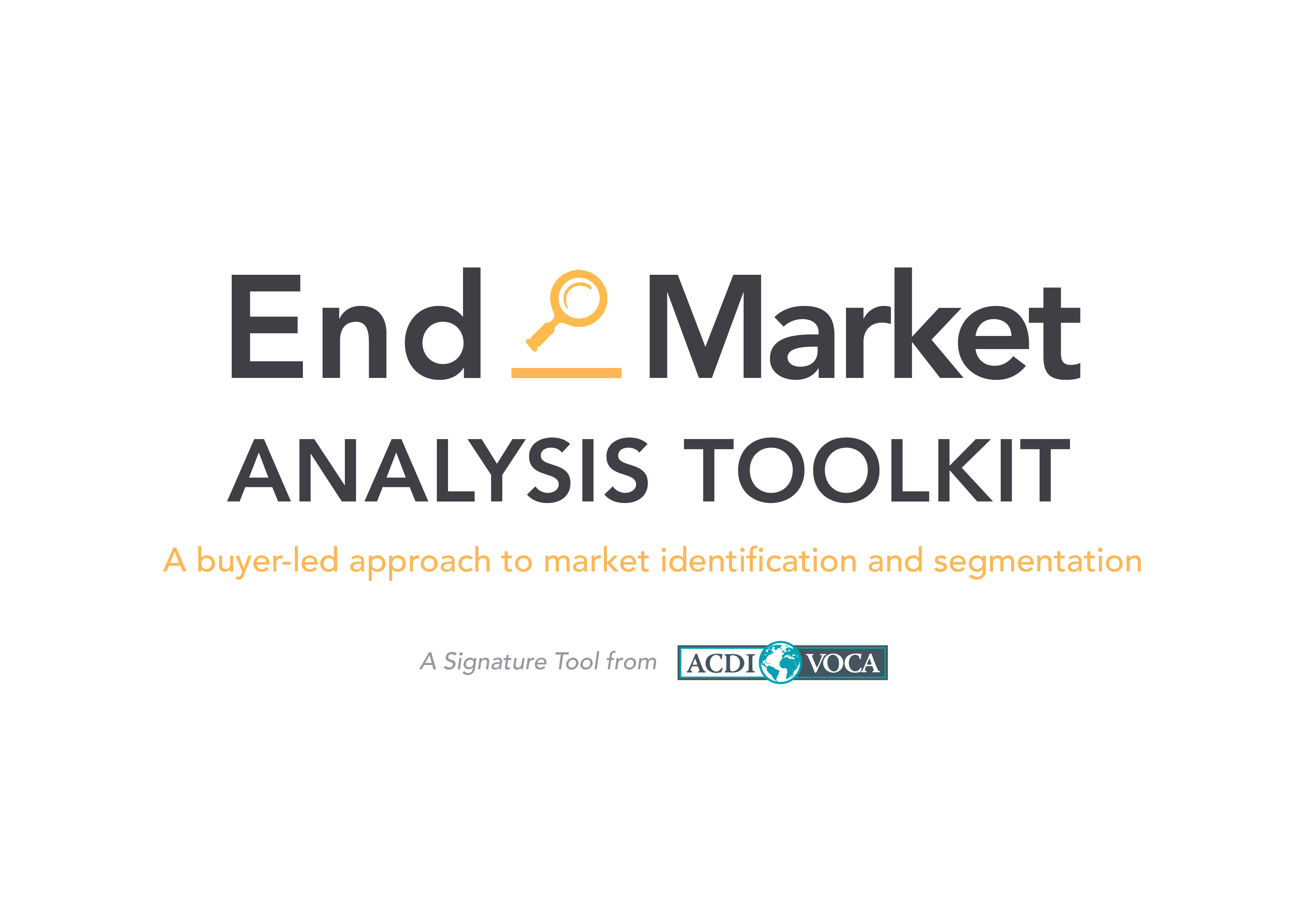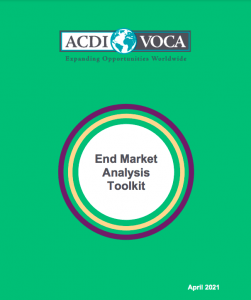

ACDI/VOCA’S inclusive market systems approach uses a variety of analytical tools and methodologies to provide a comprehensive picture of the market system and helps us determine which value chains (among other systems) are most important to our project objectives as well how those systems operate.
The End Market Analysis (EMA) Toolkit was designed to help answer some of these foundational questions by starting to draw the boundaries of the market system that our projects will focus on, guiding project activities toward high potential sectors and market segments, helping advise partners on end marketing and upgrading strategies, and enabling for segment prioritization based on the private sector’s ability to compete in segments which offer value-added opportunities at scale, are less prone to risks, and offer inclusive potential for market actors.
What It Is
This toolkit informs practitioners on the process and value of conducting an EMA for market systems development, provides recommended tools for conducting an EMA along with considerations for project-specific EMA design, and grounds these tools through case studies from the Honduras Transforming Market Systems (TMS) and Zambia EDGE projects to ensure their practical application.
The toolkit includes a scope of work (SOW) template, methodology, and final report template for conducting an EMA. The SOW and methodology were discussed, reviewed, and tested by ACDI/VOCA and its implementing partners in Honduras and Zambia. The report template was developed for and tested in Zambia and subsequently underwent minor revisions according to user feedback and lessons learned.
- EMAs can inform project strategies to improve competitiveness, resilience, and inclusivity of one or more sectors and help gather information for subsequent cross-sectoral comparison/ranking.
The EMA toolkit is designed to analyze a single VC or sector and help prioritize the most promising market segments within that VC or sector. If a project seeks information on multiple sectors, then the project should undertake multiple EMAs, one for each sector. While the EMA produces a range of data that is useful for strategic VC development, it also produces data that can be benchmarked against other VCs undergoing an EMA. That said, this toolkit does not establish a comprehensive framework for the comparison of VCs.
- EMAs may be utilized at any stage of the proposal or project cycle, depending on project needs and objectives.
An EMA may be appropriate during capture, startup, or later in the project cycle. Depending on the project/proposal’s needs, it may make sense to conduct an initial “lighter touch” EMA, which is the focus of this toolkit, that utilizes publicly available data, secondary sources, and desk research with limited key informant interviews and focus group discussions.
- EMAs can be one-off or iterative, and typically reveal areas for further research and data collection.
Depending on the country’s market dynamics, the project’s indicators, and/or the influence of external shocks over the life of the project, the EMA may be a one-off or an iterative process carried out periodically to help inform project programming and adaptive management strategies. If the market system is perceived to have significantly changed, for instance, consider conducting a follow-on EMA. For example, ACDI/VOCA’s Agriculture and Food Development Activity (AFDA) in Myanmar needed to repeat end market studies due to political and economic shocks from COVID-19 and a military coup that significantly altered supply and demand factors in target sectors of the market system.
Built into the final steps of the EMA SOW is defining recommendations for further research and (primary or secondary) data collection. Implementers should expect the EMA to uncover priority areas for further inquiry and be prepared to carry out (or contract out) additional, targeted EMA research that supports project objectives.
For aspects of the EMA SOW that were not available online or through key informant interviews (KIIs), primary data collection may be required to fill those gaps. Projects can draw on other market systems tools and analyses to fulfill these research goals. Illustrative examples of follow-on research include focused studies on market standards and certifications for high priority market segments, understanding trade policies and export documentation requirements for export-oriented segments, network analysis to understand input/output relationships, targeted analysis to identify end-markets with demand necessary to drive profitable upgrades in a sector that lead to better quality jobs for male and female youth, or pinpointing enterprise constraints to accessing finance and reaching higher value markets.
Use Case: Zambia EDGE
ACDI/VOCA’s Zambia EDGE project draws on the EMA Toolkit to inform value chain selection during the market systems analysis stage of project start-up.
Summary: Assessing competitiveness, resilience, and inclusion are fundamental to the EMA methodology and to the objectives of ACDI/VOCA’s inclusive market systems approach. Given the specialized expertise required to adequately address these topics in a sector or value chain, additional studies are needed to fill information gaps on resilience and inclusion. ACDI/VOCA’s Zambia Enterprise Development and Growth Enhanced (EDGE) Activity, for example, followed a market systems approach to value chain selection, relying on multiple analyses, including an EMA, to deliver the analytical inputs needed to carry out comprehensive indexing of value chains. The outcome was the informed selection of six competitive, resilient, and inclusive value chains.
Detail: Following a market systems approach to selecting the project’s target value chains, ACDI/VOCA’s Zambia EDGE Project developed a comprehensive value chain prioritization index to guide the selection of six high-potential value chains for the project to focus on. The index was used to assess 10 value chains across five criteria: potential for systemic change, competitiveness, inclusion, resilience, and enabling environment.
Unique indicators and weights were assigned to each criterion in alignment with the priorities of the project (e.g., inclusion criteria received the highest overall weight of 30% due to its importance to the project). A comprehensive set of studies were designed to inform the project’s start-up activities and provide the key data points, context, and scoring for the index’s 13 indicators. Using the EMA Toolkit, the project carried out EMAs for all 10 value chains.
Outputs included indicator data for most of the competitiveness and systemic change indicators as well as a subset of the inclusion and enabling environment indicators. Additional studies were carried out concurrently, including Gender, Youth, and Social Inclusion (GYSI) analysis, environment and climate risk assessments, nutrition and food security assessment, and financial systems analysis, and provided the necessary inputs for certain inclusion, resilience, and competitiveness indicators for each value chain. Weighted average scores for each value chain were then calculated and ranked, enabling the project to select the six highest scoring value chains which represented the highest-potential competitive, inclusive, and resilient VCs to move forward with over the life of the project.
Indicators/Research Questions
An EMA helps answer certain types of research questions. For each sector or value chain, these questions include:
Which value chains relate to our project goal?
What are the sector’s/VC’s existing or potential competitive advantages?
Which segments are best positioned to drive more competitive, inclusive, and resilient results?
Which market segments should project activities/funds be guided towards?
What is the current state of the market system and how does it work?
What are the current and potential productive capabilities relevant to reaching target markets?
What areas should project activities focus on to build partner capacity for end marketing and upgrading strategies?
What are the defining characteristics or attribute demands of customers within each major segment? What are the end market opportunities in terms of buyers, competitors, volumes, prices, segmentation, growth, consumption trends, differentiation, standards, and other market requirements?
At what point(s) along the VC should the project focus its interventions to maximize its impact on competitiveness, resilience, and/or inclusion?
If you seek answers to these questions, the EMA will help generate actionable responses.





